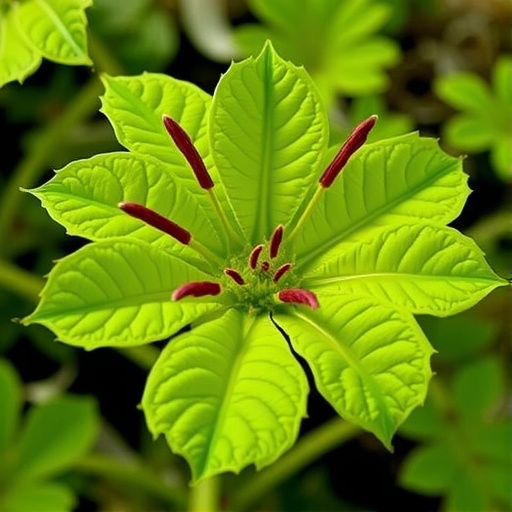In the dynamic field of plant genomics, a groundbreaking study has recently emerged that sheds light on the genetic underpinnings of one of the most resilient species of the Amaranthus genus, specifically focusing on Amaranthus tuberculatus. This species, often regarded as a troublesome weed due to its rapid adaptation and viability in diverse environments, has captured the attention of geneticists and agricultural researchers alike. The study, conducted by a team of leading scientists, offers a comprehensive analysis of contiguous reference genomes, unveiling critical insights into sex-associated genetic regions and the diversity of the PEBP (PHOTOPERIOD-RESponsive B-BOX) gene family.
At its core, the research highlights the significance of genomic sequencing in understanding the evolutionary trajectory of Amaranthus tuberculatus. By analyzing contiguous reference genomes, the researchers have uncovered a treasure trove of genetic information that not only maps the landscape of sex-linked traits but also reveals the intricate mechanisms by which this species adapts to varying climatic and soil conditions. The meticulous construction of genomic sequences provides a clear understanding of the genetic architecture that influences these adaptive phenotypes.
One of the key findings of this study is the extensive variation in the sex-associated region of the Amaranthus tuberculatus genome. This region is critical as it plays a significant role in determining sexual traits, which are essential for reproduction and species propagation. Understanding the genetic variations within this region allows researchers to examine how environmental pressures may influence sex determination and the overall reproductive success of the species. This knowledge is particularly crucial for agricultural practices, where managing the reproductive capabilities of this weed could significantly influence crop yields and sustainability.
In addition to its findings on sex determination, the study delves into the PEBP gene family, known for its role in flowering and vegetative growth regulation. The researchers discovered a remarkable diversity within this gene family, suggesting a complex evolutionary history that may confer adaptive advantages to Amaranthus tuberculatus. The PEBP genes are critical given their involvement in controlling plant responses to environmental stimuli, which is essential for fitness and survival. The implications of this diversity extend beyond theoretical biology, offering tangible applications for crop breeding and management practices.
The methodological approach employed by the researchers is equally significant. Utilizing cutting-edge genomic sequencing technologies, the team meticulously constructed a high-quality reference genome utilizing advanced computational tools for data analysis. This approach facilitates not only the analysis of genomic sequences but also enhances our understanding of genomic regions associated with adaptive traits. The ability to effectively harness genomic data represents a monumental leap forward in agricultural science, equipping researchers with the tools needed to tackle the challenges posed by resilient weed species.
Moreover, this investigation into the genomic landscape of Amaranthus tuberculatus opens new avenues for exploring gene-environment interactions. As global climate change continues to alter ecosystems, understanding how genetic diversity influences adaptability becomes increasingly critical. The findings underscore the necessity for plant scientists to adopt a holistic approach, considering both genetic makeup and environmental factors. With climate-driven changes, the race to understand plant resilience has never been more urgent.
The consequences of this study extend beyond academia; they translate directly into practical benefits for agriculture and ecosystem management. By elucidating the genetic factors that underpin adaptability, researchers can better inform strategies aimed at managing wild populations of Amaranthus tuberculatus in agricultural settings. This research paves the way for developing more sustainable weed management practices that balance the need for crop production with the ecological integrity of agricultural systems.
As we stand at the forefront of genomic research, this study epitomizes the shift towards leveraging genetic information to solve practical problems in agriculture. It highlights how understanding the underlying genetics of crop relatives can provide invaluable insights into managing both beneficial and troublesome species. The implications of these findings are vast, with the potential to revolutionize how we approach crop breeding, pest management, and ecosystem resilience.
Furthermore, this work emphasizes the importance of collaborative research in advancing our understanding of plant genetics. By bringing together expertise from various fields, including genetics, ecology, and agriculture, we can develop a more comprehensive approach to studying complex traits and their interactions with environmental variables. This collaborative spirit is essential for driving innovation in agricultural practices.
In conclusion, the analyses of contiguous reference genomes of Amaranthus tuberculatus accomplish more than just mapping genetic traits; they invite us to rethink our relationship with resilient weeds in an era of rapid environmental change. By focusing on how genetic diversity contributes to survival and adaptability, we can develop more effective management strategies that protect crops without compromising ecological balance. This research stands as a testament to the power of genomics in addressing modern agricultural challenges, illuminating pathways for future exploration in plant science and sustainable agriculture.
With the completion of this pioneering research, the authors have opened a new chapter in understanding the complexities of plant adaptation, providing robust data that future research can build upon. There is a call to action for scientists worldwide to delve deeper into the genetic architectures of both beneficial and invasive plant species, utilizing these insights to foster agricultural practices that align with ecological principles. The future of agriculture may very well hinge on our understanding of genetic intricacies, and with studies like these, we are equipped to meet the challenge head-on.
Subject of Research: Genomic analysis of Amaranthus tuberculatus
Article Title: Analyses of contiguous reference genomes of Amaranthus tuberculatus highlight the landscape of the sex-associated region and PEBP gene family diversity
Article References:
Raiyemo, D.A., Cutti, L., Patterson, E.L. et al. Analyses of contiguous reference genomes of Amaranthus tuberculatus highlight the landscape of the sex-associated region and PEBP gene family diversity.
BMC Genomics 26, 988 (2025). https://doi.org/10.1186/s12864-025-12181-w
Image Credits: AI Generated
DOI: https://doi.org/10.1186/s12864-025-12181-w
Keywords: Amaranthus tuberculatus, genomic analysis, sex-associated region, PEBP gene family, adaptation, agriculture, weed management, genetic diversity, evolutionary biology, environmental interaction.




